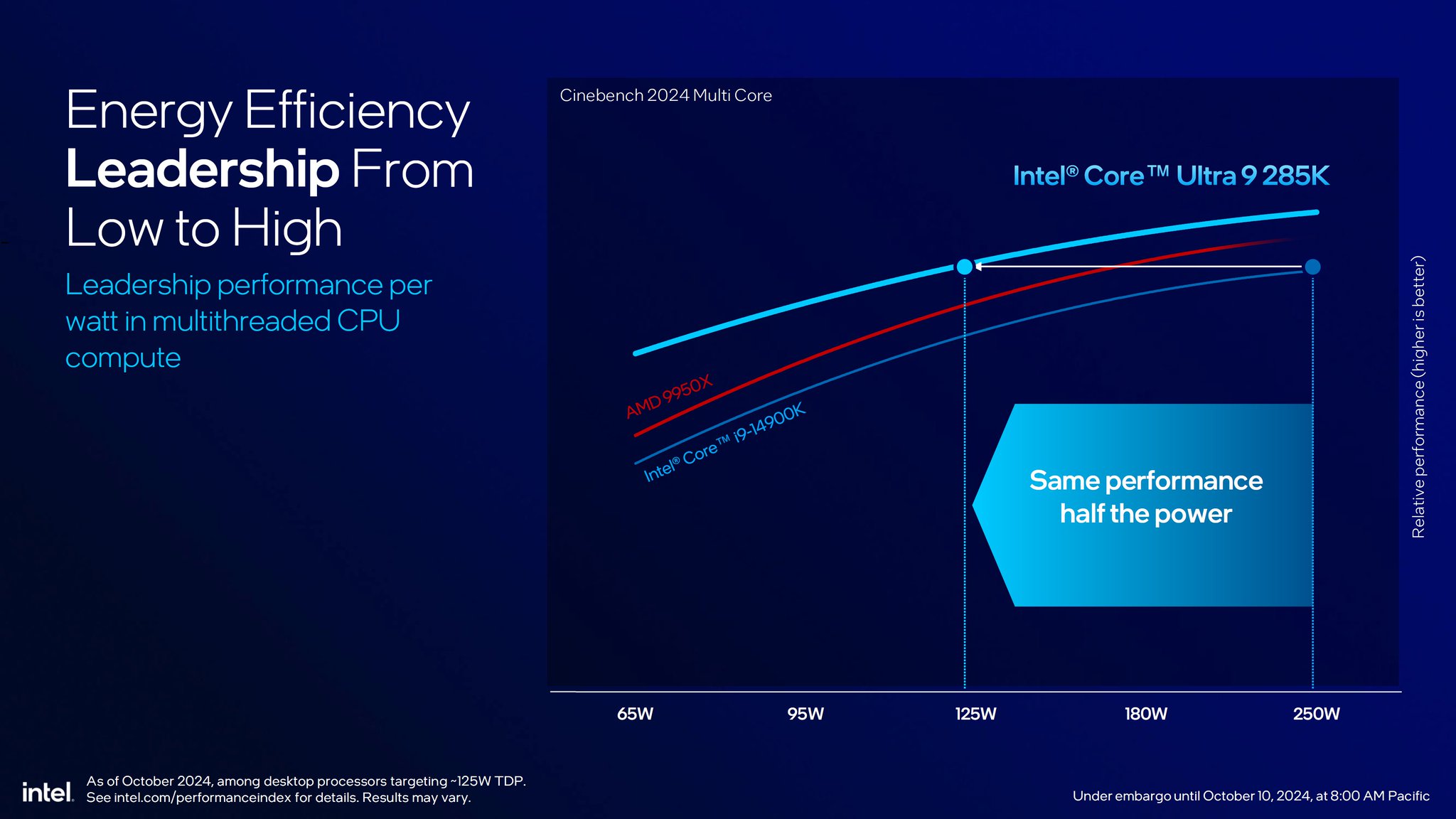Draugoth
Gold Member
:format(webp)/cdn.vox-cdn.com/uploads/chorus_asset/file/25666085/core_ultra_series2_k_hero_08.png)
Intel is finally addressing how hot and power-hungry its desktop CPUs have become. Intel's new flagship Core Ultra 200S series of processors, arriving on October 24th, are focused on performance per watt to run cooler and more efficiently than the previous 14th Gen chips. Codenamed Arrow Lake S, these are also Intel's first enthusiast desktop CPUs with a built-in NPU, or a neural processing unit, for accelerating AI tasks.
"Arrow Lake will deliver Intel's best performance for enthusiasts in desktop and mobile," says Josh Newman, general manager and VP of product marketing client computing. "It will deliver that performance at significantly lower power levels than previous generations of Intel enthusiast products, and Arrow Lake is also delivering the first Intel AI PC for enthusiasts in both the desktop and mobile performance space."
:format(webp)/cdn.vox-cdn.com/uploads/chorus_asset/file/25667485/coreultra200series.png)
The full Core Ultra 200S lineup. Image: Intel
At the heart of the Arrow Lake architecture is a big effort from Intel to reduce the power draw from its chips. Both the 13th and 14th Gen Intel Core CPU generations were power-hungry, often drawing far much more power than their AMD equivalents. These new Core Ultra 200S series chips will halve the power consumption when you're doing basic desktop tasks, and Intel claims they'll shave off lots of watts during gaming, too.
"You'll see about half the power consumption at the desktop," says Robert Hallock, vice president of client computing group at Intel. "You'll also see about half the power when you're just using a single core. Gaming it's going to be up or down, 50 to 150 watts just depends on the title and its behavior."
During a recent press briefing, Intel demonstrated Assassin's Creed Mirage running on its flagship Core Ultra 9 285K compared to its current Core i9-14900K. The Ultra 9 285K delivered similar or better performance at 80 watts less in Mirage, and Intel claims it will reduce power by up to 58 watts in games like Call of Duty: Modern Warfare III, F1 24, and Total War: Pharaoh. There are some extreme cases like Warhammer: Space Marines 2 where the Ultra 9 285K even runs at 165 watts less than the 14900K.
:format(webp)/cdn.vox-cdn.com/uploads/chorus_asset/file/25667487/coreultra200series3.png)
Intel's power claims for the Core Ultra 9 285K. Image: Intel
Intel also claims the package temperatures of the Core Ultra 9 285K will drop by around 13C compared to the 14900K during gaming at 1080p with a 360mm all-in-one cooler. While Intel is moving to its new LGA-1851 socket with these new chips, existing all-in-one coolers should work just fine. You may need to speak to your cooler manufacturer to confirm whether you need additional standoffs, but Corsair confirmed to The Verge that all of its coolers that supported LGA-1700 also support LGA-1851.
Intel is using its latest 3D packaging technology to build the Core Ultra 200S series chips, and the package size has been reduced by 33 percent over the 14th Gen chips. There are some interesting changes as a result of this new package. The flagship Ultra 9 285K will ship with 24 cores, 24 threads, and a boost clock of 5.7GHz. That's a slower boost clock and eight fewer threads than the previous 14900K, as Intel has removed hyperthreading in favor of power efficiency here. "We knew we could save the wattage for hyperthreading by not including it," says Hallock.
The Ultra 9 285K will have eight performance cores (P-cores) and 16 efficiency ones (E-cores). The E-cores have been upgraded with more efficiency to process instructions, and there's even a reduction in latency. There will be 36MB L3 shared smart cache, 3MB of L2 per P-core (up from 2MB on 14th Gen), and 4MB of L2 per E-core. Intel is claiming that the Ultra 9 285K will be around 8 percent faster in single-thread tasks compared to the 14900K and around 15 percent faster on multi-threaded workloads.
:format(webp)/cdn.vox-cdn.com/uploads/chorus_asset/file/25667488/coreultra200series4.png)
Intel's Core Ultra 9 285K will trade blows with AMD's Ryzen 9 9950X in gaming. Image: Intel
Intel has also provided some limited benchmarks for gaming with the Ultra 9 285K up against AMD's Ryzen 9 9950X and Ryzen 9 7950X3D processors. It looks like Intel's latest flagship will be trading blows with AMD's flagship Zen 5 desktop CPU, but on the X3D side, it's clear from Intel's own data that it will be behind. Intel is also being surprisingly transparent about being behind the best gaming CPU right now, AMD's Ryzen 7 7800X3D.
"I think we'll be about five percent back versus X3D parts, which we feel really good about considering we have just the cache that's built into the CPU and the great IPC of the product," says Hallock. "You'll see about a five percent deficit and I want to be clear about that."
:format(webp)/cdn.vox-cdn.com/uploads/chorus_asset/file/25667489/coreultra200series5.png)
Intel is being clear the Core Ultra 9 285K will lose out to AMD's X3D chips in gaming performance. Image: Intel
That's disappointing for the gaming side of things, but Intel claims it will still hold the performance crown for most creator and AI tasks. It has even added an NPU to the Ultra 9 285K, which will be able to accelerate certain AI tasks. It's only capable of 13 TOPS, meaning these processors won't qualify for Microsoft's Copilot Plus features that require a 40 TOPS or better NPU. Intel is hoping that as NPU adoption grows, developers will be able to leverage this to offload tasks and even for some gaming-related features.
"It was fully possible to put a 40 TOPS NPU on this product, but to do so would require shrinking core count or changing GPU core count," admits Hallock. "You start making sacrifices in fundamental performance dimensions that enthusiasts really do care about. That didn't feel like the right mix. We also talked at length about the enthusiast market's disposition on AI as a whole, and I think it's fair to say it's somewhat reluctant."
A new LGA-1851 socket also means new motherboards. You'll need a new Z890 board to use the Core Ultra 200S desktop CPUs. Intel's 800 series chipset supports up to 24 PCIe 4.0 lanes, up to 8x SATA 3.0, and up to 32 USB 3.2 ports. The platform supports a total of 48 PCIe lanes, with up to 20 of those being Gen 5 from the CPU. There's also integrated Wi-Fi 6E and 1GbE, Bluetooth 5.3, and 2x Thunderbolt 4 on the CPU, with motherboard makers able to add discrete options for Wi-Fi 7, up to 4x Thunderbolt 5 ports, 2.5GbE, and Bluetooth 5.4.
:format(webp)/cdn.vox-cdn.com/uploads/chorus_asset/file/25667490/coreultra200series6.png)
The new 800 series chipset provides plenty of PCIe and USB connectivity. Image: Intel
Intel is also improving memory support with the Core Ultra 200S series and Z890 motherboards, supporting up to DDR5-6400, up to 48GB per DIMM, and up to 192GB max capacity. DDR4 support has been dropped for the 800 series chipset. These chips are also Secure Core compliant and include three built-in hardware engines for security.
It's not clear how long the LGA-1851 socket will last, though. AMD has committed to supporting AM5 to 2027 or beyond, but Intel is refusing to comment on future product plans. With rumors of an Arrow Lake S refresh being canceled in favor of a leap to Nova Lake, it's possible the LGA-1851 socket won't be around for long. Intel launched its LGA-1200 socket in 2020, before replacing it with the LGA-1700 a year later, so hopefully history won't repeat itself again.
The Arrow Lake reveal comes just days after Intel said its Raptor Lake crashing nightmare is finally over. Instability issues with 13th and 14th Gen chips have now been addressed, with a too-high voltage issue as the root cause. Intel's new Arrow Lake chips won't be impacted by the Raptor Lake voltage problems.
Intel's new Core Ultra 200S chips will start shipping on October 24th, with the flagship $589 Core Ultra 9 285K, a $394 Core Ultra 7 265K, and the $309 Core Ultra 5 245K. Intel is also launching KF variants of the Ultra 7 265KF ($379) and Ultra 5 245KF ($294) without the built-in GPU.
Last edited:











